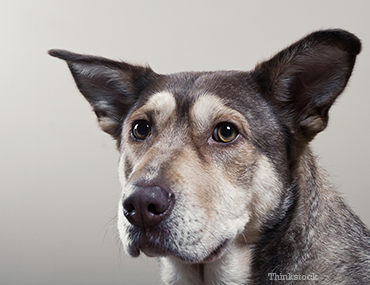
Why don't dogs bruise like people do?
While trauma (e.g., being hit by a car) can often cause bruising in dogs, just playing or rough housing should not typically result in bruising. That’s because dogs have a thicker epidermis (skin) and coat that protects them from bruising more than it does for humans. As a result, when we see dog bruising, we worry about an underlying platelet problem or clotting problem.
Where might I notice bruising on my dog?
Bruising in dogs is never normal, and signs of pinpoint bruises (called petechiae) or larger bruises (ecchymosis) warrant an immediate trip to your veterinarian. Of course, your veterinarian will rule out more benign causes (such as hives or an allergic reaction that can look similar to a bruise).
Bruising is easiest to see on the gums of your dog, inside thigh, or on the belly (where there is less fur).
What other symptoms might appear with bruising on my dog?
If you notice any signs of bruising, you and your veterinarian will also need to make sure and rule out other clinical signs of a bleeding problem:
- Blood in the back of the eye, giving a red hue to the globe
- Bleeding from the nose
- Small pin-point bruising of the skin (called petechiae)
- Larger bruises (called ecchymosis)
- Increased heart rate
- Difficulty breathing
- Increased respiratory rate
- Abnormal bleeding from any orifice
Normally, the body’s ability to clot is complex and involves multiple stages and key components such as tissue factor, platelets, clotting factors, fibrin, and components that break down fibrin. In certain diseases, the body loses the ability to clot normally and uncontrollable, life-threatening bleeding (i.e., hypocoagulability) or abnormal clotting (e.g., hypercoagulability) may be seen.
What might cause bruising and what could it mean?
 If your dog does have bruising, your veterinarian will ask important questions to rule out the following:
If your dog does have bruising, your veterinarian will ask important questions to rule out the following:
- Any possible toxicity or poisoning that could have caused this (NSAIDs, aspirin, mouse or rat poison, etc.)
- Any exposure to ticks
- Any trauma
- Any previous blood transfusions
- Any previous surgeries or bleeding tendencies
- Any history of bleeding in the parents or other pedigree
Answering these questions carefully and truthfully is important, as it will help determine if the bruising is from a congenital source (i.e., something your dog was born with or inherited) versus something that developed all of a sudden as an adult due to disease (acquired).
Congenital causes for bruising include the following:
- Hemophilia (a factor deficiency)
- Von Willebrand’s disease (vWD)
Certain inherited clotting abnormalities are seen more commonly in males (due to a sex-linked trait). Due to an inherited component, von Willebrand’s disease is seen more commonly in certain breeds, particularly Doberman Pinschers, Scottish Terriers, Shetland Sheepdogs, German shepherds, and German Shorthaired Pointers.
Acquired causes for bruising include the following:
- Immune-mediated thrombocytopenia (i.e., when your dog’s own immune system destroys its own platelets inappropriately)
- Disseminated intravascular coagulation (DIC)
- Infectious causes (often due to ticks which pass on organisms like Ehrlichia, Rocky Mountain Spotted Fever [RMSF] or Anaplasma that affect platelets)
- Metabolic problems (e.g., liver failure or even cancer)
If your dog has bruising, your veterinarian will also want to run some diagnostic tests that typically include:

- A CBC which looks at the red blood cell count, white blood cell count, and platelet count
- A manual platelet count, which accurately assesses the platelet count
- Blood flim analysis
- A biochemistry panel to assess kidney and liver function, protein, and electrolytes
- A prothrombin (PT) and partial thromboplastin time (PTT) to assess clotting of the body
- An activated clotting time (ACT), which is not quite as accurate but more readily available
- An IDEXX 4DX SNAP test to rule out tick-born infections
- A buccal mucosal bleeding time (BMBT), which assess if adequate von Willebrand factor and platelets are available
- A von Willebrand factor (vWF) blood level, which is important if you have a high-risk breed about to go through elective surgery (like a spay or neuter)
- Chest and abdominal x-rays – or even ultrasound – to look for other sources of bleeding into the lungs, chest cavity, or abdomen
[Note: ACT and BMBT tests are both significantly affected by low platelets in the body; if your dog is already diagnosed with a low platelet count, your veterinarian might not recommend doing these two tests, as it will be prolonged just from a low platelet count.]
Treatment of bruising
Once your veterinarian is able to determine the cause of bruising, further treatment wil also be determined. Treatment may include intravenous (IV) fluids, blood transfusions, plasma transfusions (for von Willebrand’s disease or mouse/rat poison, steroids (for immune-mediated hemolytic anemia), Vitamin K1 therapy (for mouse and rat poison or liver failure), or symptomatic supportive care.
So, when it comes to bruising, don’t blow it off. The sooner you notice the bruising, the sooner your veterinarian can identify the underlying cause and focus on treatment. As dogs have fur, it’s often difficult to notice any small bruises, but when you’re giving that belly rub, check for bruises (and ticks or bumps!).
If you have any questions or concerns, you should always visit or call your veterinarian -- they are your best resource to ensure the health and well-being of your pets.
